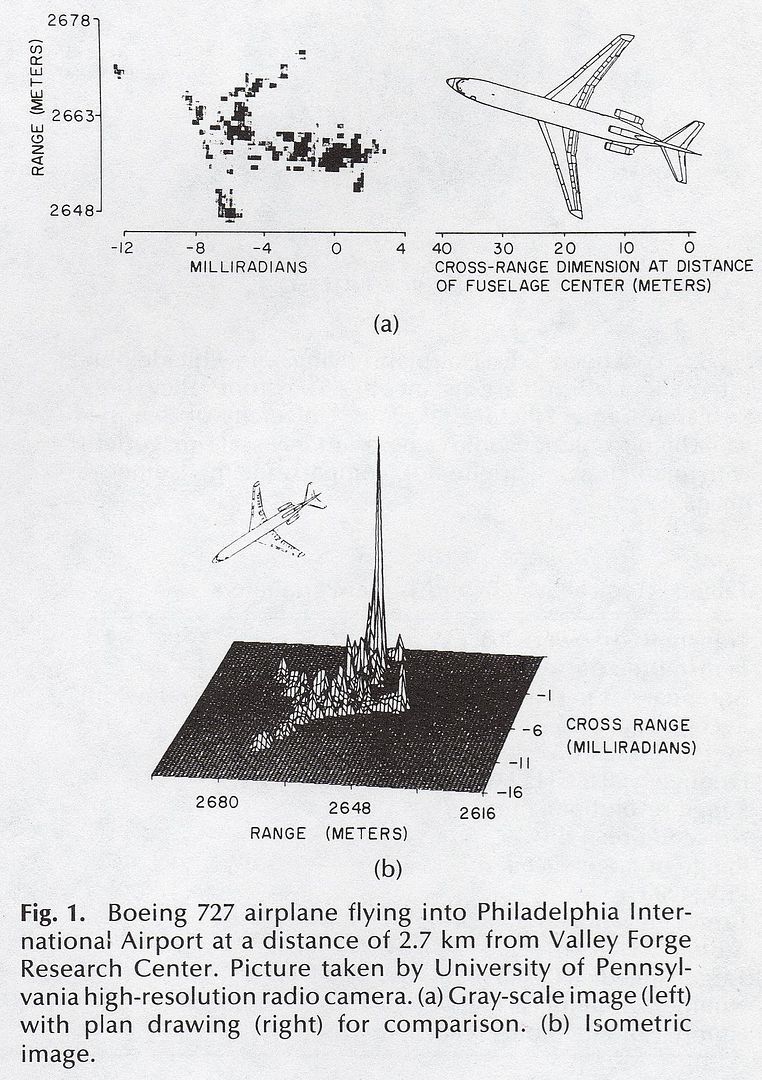If you take two cubes of different sizes but identical proportions, then you rotate them under radar bombardment, you will have nearly identical RCS values with only difference in amplitude. The smaller cube will have the lower RCS. What this mean is that complex bodies will produce unique RCS signal characteristics and the more complex the body, the higher that unique-ness particular to that body.
If you take the above example of a 727 under radar bombardment, you will see voltages unique to a body that contains a long tube that is bisected by an elongated and thin plate. How many complex bodies -- airliners -- in the sky that matches that electrical description? How about the 747? Or the DC-10? Or even the WW II B-17 Flying Fortress? Or how about the WW I Sopwith Camel? In fact, with the exception of the flying wing, the blimp, and the flying saucer (UFO), most complex bodies that flies -- aircrafts -- contains a common electrical (radar) theme: A long tube bisected by a long plate.
The problem, therefore, is how to extract that cluster of electrical signals from out of the background noise.
Radar detection is 75% data processing, meaning what to do with the radar returns when we received them. In the early days of radar (WW II), data processing was downright primitive so the only display we have is called the 'a-scope'...
Today, the radar scope can display these vital basic target resolutions...
- Altitude
- Speed
- Heading
- Aspect angle
More sophisticated systems can identify the type of aircraft based upon known common denominators such as a long tube bisected by an elongated plate, aka a heavy cargo type aircraft such as an airliner or a bomber.
A long straight wing will produce one type of radar return. A cropped delta wing will produce a different type of radar return. The problem is to take a cluster of radar signals, extract highly unique characteristics such as a long straight wing or a cropped delta, and match them against a known database.
If the long straight wing have highly scintillating signals attached, we may be looking at propellers? If that same long straight wing have scintillating signals unique to rotating blades but far less intense, we may be looking at podded jet engines? This level of data processing is difficult even to today. Difficult, but not impossible and usually cost money to produce.
For 'stealth', the data processing problem is compounded by the fact that a cluster of highly unique signals is masked by background noise. Imagine the 727 example is below the base graph. That is the goal of 'stealth': To insert the aircraft into background noise or clutter. The data processing problem now is to extract that cluster out of background noise
BEFORE you can begin to analyze that cluster and match it against a known database.
You have to know to the best of your knowledge what are electrically unique to an airliner, a blimp, a flying wing, a delta wing aircraft, a glider, a hang glider, a propeller, a podded jet engine, and even a car or tank. Then you program all of these information into your radar system and delve deep into background noise and hunt for these unique clusters. If your hardware is not capable of distinguishing a flock of birds from spinning propellers, then you will be chasing a lot of ghosts. Wasting fuel, time, manpower, and possibly lose a war.
In sum, we know how to extract unique man-made radar returns out of background noise and am not going to cross the line in saying how. We did not stop at this line when we created the F-117, meaning we already knew how to defeat it when we deployed it. The Chinese J-20 and J-whatever are already dead.








